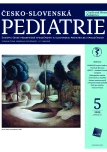Hemorrhagic disease of the newborn caused by vitamin K deficiency
Authors:
Fiamoli Veronika; Blatný Jan
Authors‘ workplace:
Oddělení dětské hematologie a biochemie, Lékařská fakulta Masarykovy univerzity a Fakultní nemocnice Brno
Published in:
Čes-slov Pediat 2022; 77 (5): 303-305.
Category:
Chapters for Specialization in Pediatrics
doi:
https://doi.org/10.55095/CSPediatrie2022/049
Overview
Hemorrhagic disease of a newborn is manifested by unexpected bleeding mostly in otherwise healthy newborns and infants and is caused by vitamin K deficiency, which leads to insufficient activity of vitamin K-dependent coagulation factors. The cause is the low level of vitamin K in breast milk and the insufficient synthesis of vitamin K by the neonatal bifid intestinal microflora. There are three forms of this disease, early-onset (0-24 hours), classic (2-7 days) and late-onset (2-12 weeks). Risk of severe intracranial bleeding is typical for the early and late forms, with up to 50% mortality in the late form. The diagnostic standard is the examination of the prothrombin time greater than 4 times the normal values in the presence of a normal level of platelets and fibrinogen. The treatment of an already developed disease is vitamin K, in severe cases also fresh frozen plasma (in children optimally Octaplas®). Since the sixties of the 20th century, the prophylactic administration of vitamin K has been recommended worldwide. As a part of the differential diagnosis in newborns with intracranial bleeding, it is always necessary to rule out trauma, hereditary bleeding disorders such as hemophilia, but also thrombocytopathy or thrombocytopenia.
Keywords:
vitamin K – Prophylaxis – newborn – hemorrhagic disease
Sources
1. Towsend CW. The hemorrhagic disease of the newborn. Arch Pediatr 1894;11: 559–65.
2. Sutor AH. Vitamin K deficiency bleeding in infants and children. Semin Thromb Hemost 1995; 21(3): 317–29.
3. Raju NT. The Nobel chronicles 1943: Henrik Carl Peter Dam (1895–1976; and Edward Adelbert Doisy (1893–1986). Lancet 1999; 353(9154): 761.
4. Hand I, Noble L, Abrams SA. Vitamin K and the newborn infant. Pediatrics 2022; 149(3): e2021056036.
5. Araki S, Shirahata A. Vitamin K deficiency bleeding in infancy. Nutrients 202; 12(3): 780.
6. Senn V, Bassler D, Choudhury R, et al. Microbial colonization from fetus to early childhood-a comprehensive review. Front Cell Infect Microbiol 10: 573735.
7. Lippi G, Franchini M. Vitamin K in neonates: facts and myths. Blood Transfus 2011; 9: 4–9.
8. Deblay MF, Vert P, Andre M, Marchal F. Transplacental vitamin K prevents haemorrhagic disease of infant of epileptic mother. Lancet 1982; 1: 1242.
9. Pichler E, Pichle L. The neonatal coagulation systém ant the vitamin K deficiency bleeding – mini review. Wien Med Wochenstr 2008; 158: 385–95.
10. Marchili MR, Santoro E, Marchesi A, et al. Vitamin K dficiency: a case report and reviw of current guidelines. Italian J Pediatr 2018; 44: 36–41.
11. Autret-Leca E. Jonville-Béra APOD. Vitamin K in neonates. Pediatr Drugs 2001; 3: 1–8.
12. Shearer MJ. Vitamin K deficiency bleeding (VKBD). Blood Rev 2009; 23: 49–59.
13. Hanzl M. Prevence krvácení novorozenců a malých kojenců způsobené nedostatkem vitaminu K. Pediatr Praxi 2011; 12(1): 60–66.
14. Sutor AH, von Kries R, Cornelissen EAM, et al. ISTH Pediatric/Perinatal Subcomittee International Society on Thrombosis and Haemostasis. Vitamin K deficiency bleeding (VKDB) in infancy. Thromb Haemost 1999; 81: 456–61.
15. Puckett RM, Ofringa M. Prophylactic vitamin K for vitamin K deficiency bleeding in neonates. Cochrane Database Syst Rev 2000; 4: CD002776.
16. Dokoupilová M. Prevence deficitu vitaminu K. Doporučený postup České neonatologické společnosti 2021. Dostupné z: https: //www.neonatologie. cz/doporucene-postupy.
17. Van Winckel M, De Bruyne R, Van del Velde S, Van Biervliet S. Vitamin K, an update for the paediatrician. Eur J Pediatr 2009; 168: 127–134.
18. Behera MK, Kulkarmi SD. Vitamin K deficiency haemoragic disease of newborn and present controversies. Med J Armed Forces India 1998; 54(2): 143–145.
Labels
Neonatology Paediatrics General practitioner for children and adolescentsArticle was published in
Czech-Slovak Pediatrics

2022 Issue 5
Most read in this issue
- Hemorrhagic disease of the newborn caused by vitamin K deficiency
- Disseminated intravascular coagulation in children
- Algorithm for recognition a seriously ill child
- Inherited coagulation disorders
